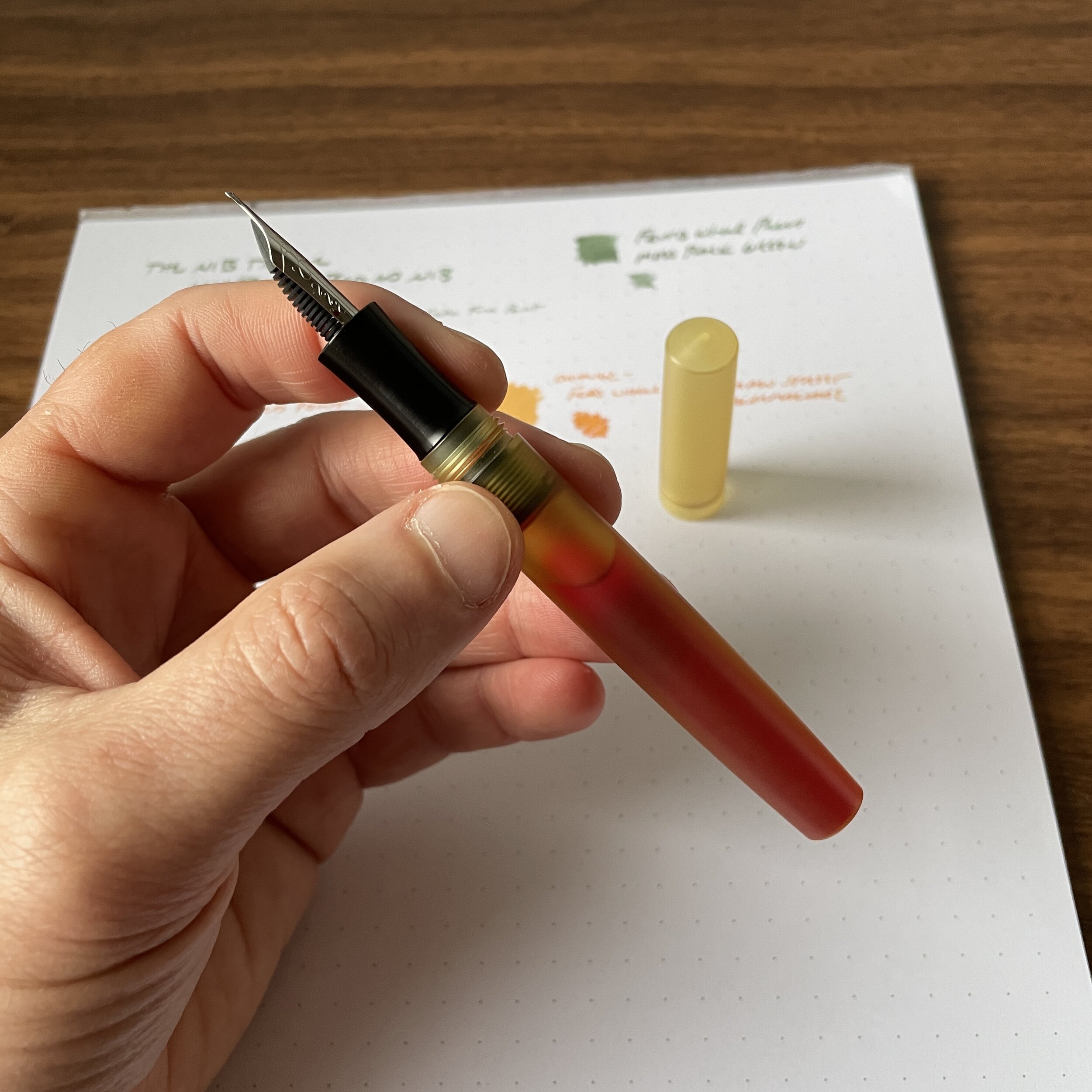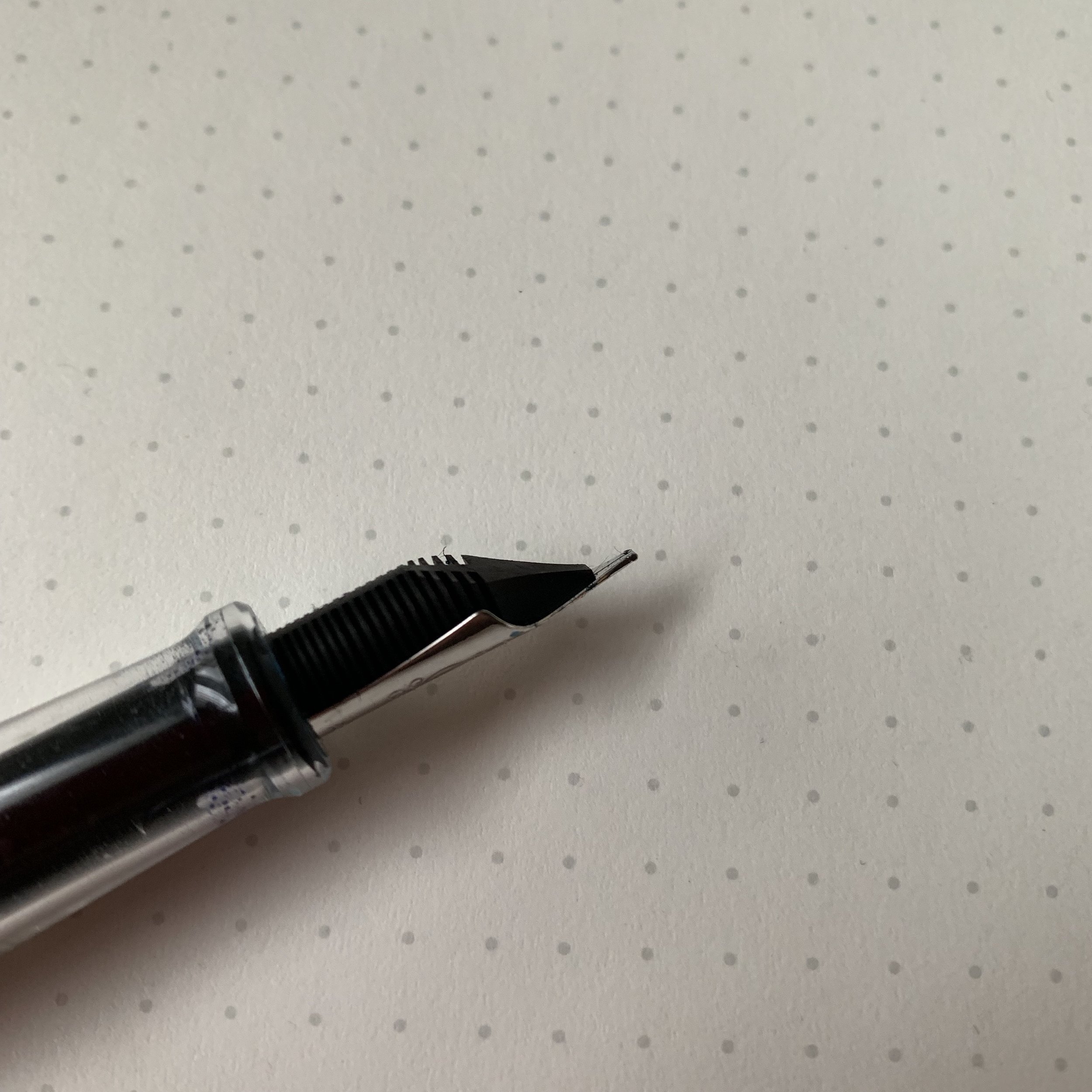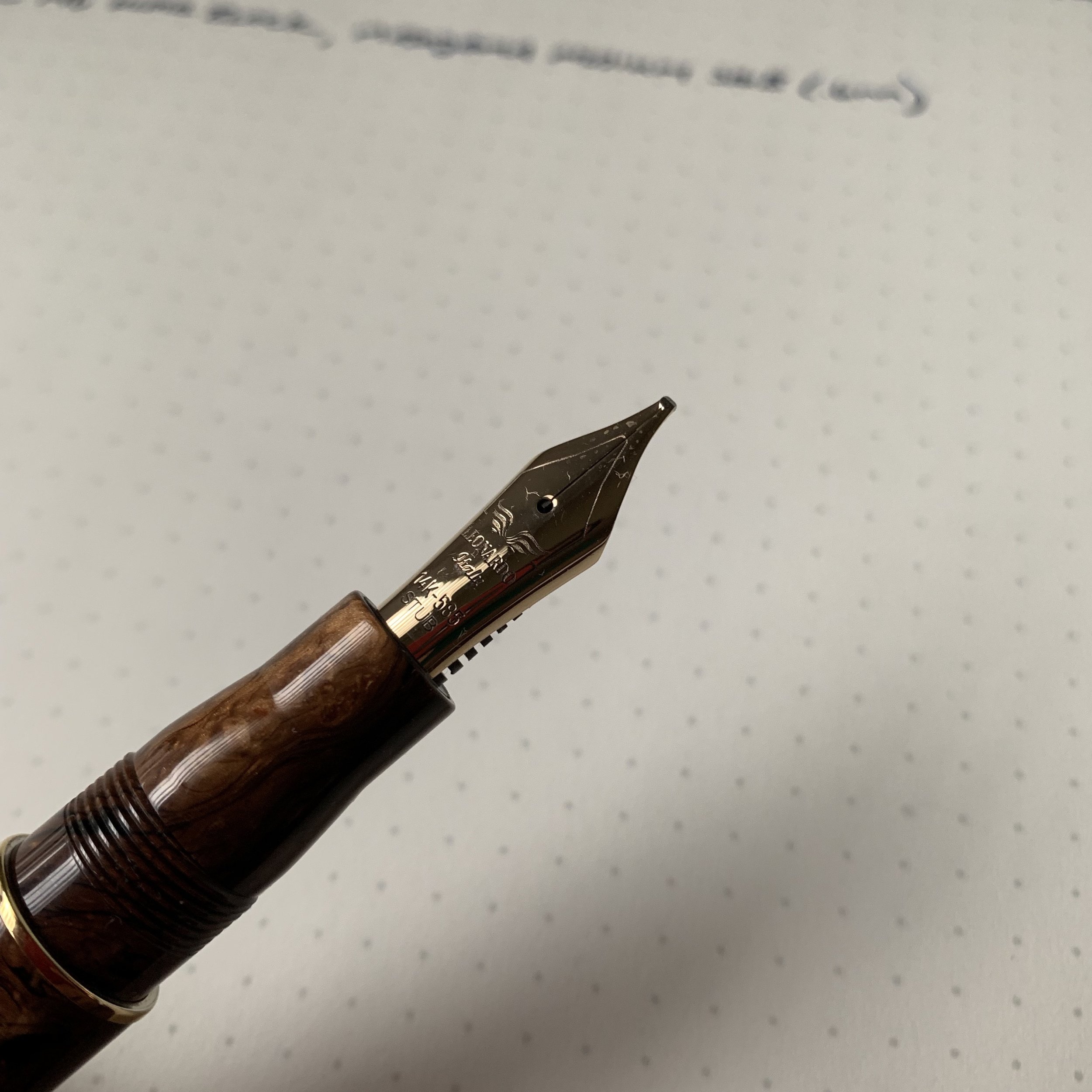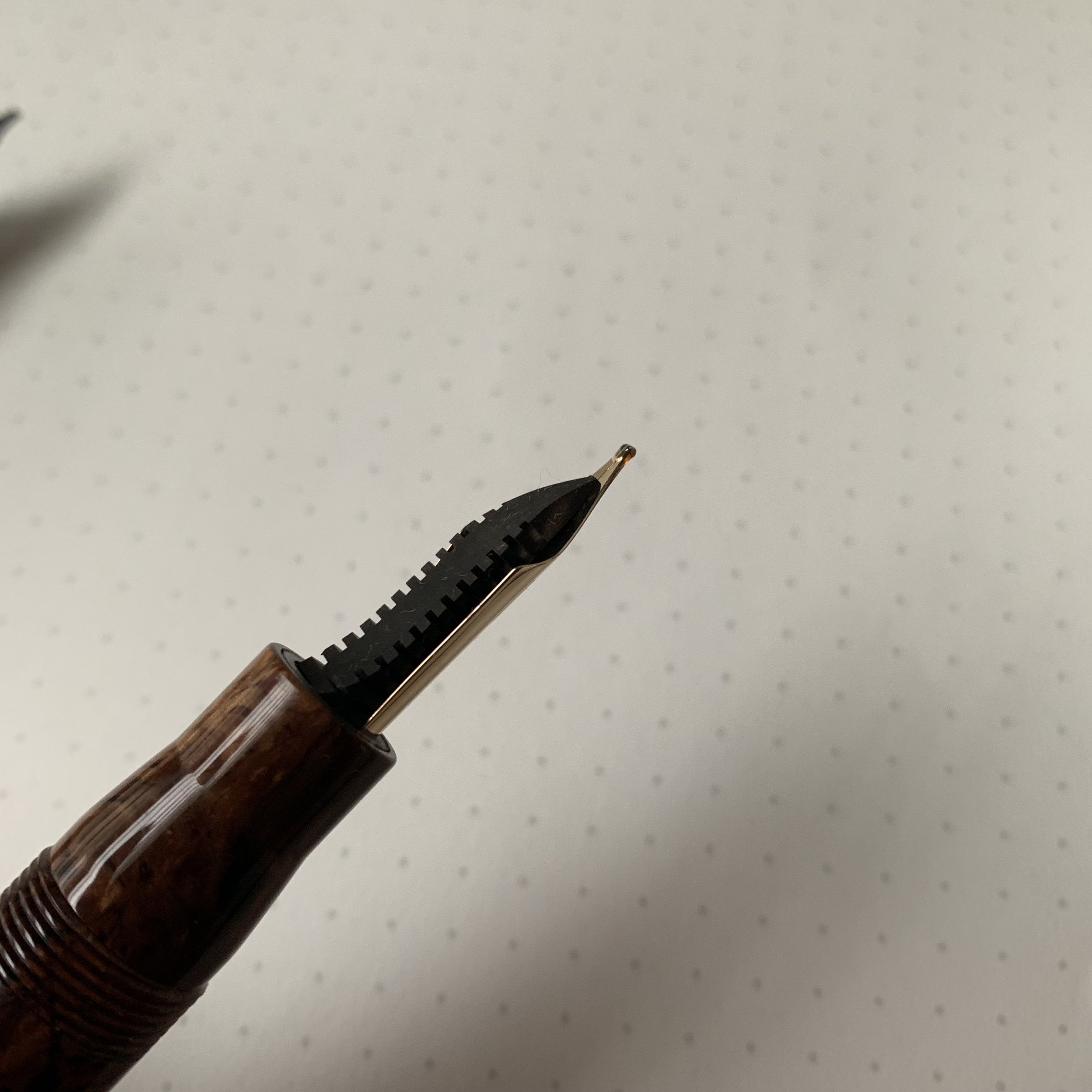I’m traveling this weekend, but during a bit of downtime this morning I finalized my latest update to the site resources: a page aggregating all of the previous reviews and posts on specialty and custom nibs. I plan to supplement this as I work my way though a longer ongoing project in which I’m taking the time to compare and review different specialty grinds from many different pen companies and nib grinders. Honestly, this project will probably never be complete, but since nib grinds and nib customization have become such a huge part of the “experience,” I figured a resource like this would be helpful. Enjoy!
Today’s review pens: a Scriptorium Balladeer and Schon DSGN Ultem Fountain Pen.
Spotlight On: The Nib Tailor, Featuring Architect + Inverted Architect Nib Grinds
I’ve known J.C. Ament for years, from way back when he was attending shows as an enthusiast, to when he started dabbling in nib work under his previous brand, Nibs on Point. I wanted to take a moment today to let everyone know about his latest endeavor, in which he’s embarked on nib work full time as “The Nib Tailor.” Before he took a break from pen shows, J.C. sent me two examples of his work for review: a broad “standard” Architect nib that has since lived in my Scriptorium Balladeer, and what J.C. calls an “Inverted Architect,” a nib that I’ve swapped between a bunch of different pens but which now lives in my Schon DSGN Ultem.
Before we get started looking at nib grinds, check out this eyedroppered Schon DSGN Ultem fountain pen, which is shown here holding a full 4ml ink sample!
Standard Architect Nib vs. Inverted Architect Nib
For newer readers, or those unfamiliar with specialty nib terminology, an Architect nib (also sometimes referred to as a “Hebrew Italic”) is the reverse of your classic stub or italic-style nib in that an Architect has broad cross-strokes and narrow downstrokes. If the grinder is skilled, you can usually use the reverse side as a needlepoint, or ultra-extra fine, nib.
Architect’s Nib Grind, with the signature blade-like shape. Turn the nib over and write with the tip for an extra-fine line.
An “Inverted Architect” is, well, the inverse: it’s basically a needlepoint/extra-fine nib with an Architect grind on the top, which you can use if you invert the pen. For my particular writing style and use case, the Inverted Architect serves a unique purpose: annotation and highlighting. I can use the extra-fine tip to take notes in the margins of documents, and the Architect side for highlighting/underlining, provided I select an appropriate ink color such as a bright orange or green.
“Inverted Architect” Nib Grind, with the needlepoint tip and “flat top.”
Writing samples for both a standard Architect nib (top, in Ferris Wheel Press Moss Park Green), and an Inverted Architect (bottom, in Ferris Wheel Press Main St. Marmalade), both inks courtesy of Vanness Pens.
A Word of Caution: If you’re new to fountain pens, or have never used an Architect nib, I would strongly advise you to consider borrowing one from a pen friend or visit a pen show prior to ordering this particular grind. Architect grinds can be a bit temperamental, in the sense that they can go from smooth to scratchy very quickly depending on the angle at which you hold your pen (and they’re not “butter smooth” writers to begin with, since you’re essentially making cross-strokes with a blade). It’s extremely important that the nib grinder understands your writing angle, so if you cannot visit in person, I would send multiple photos of how you hold the pen and the angle at which the nib hits the paper. That said, if you do decide that an Architect nib is for you, this grind gives your writing truly unique character. For those interested in reading further, I’ve previously written posts about various options for nib customization.
The Nib Tailor - Available Grinds and Pricing
The two nibs shown here are just a small selection of what The Nib Tailor has to offer. You can choose from pretty much any custom nib grind, and J.C. has a detailed form for you to complete alongside your inquiry. In addition to custom work (i.e., where you send in your pen), you can purchase pre-ground nibs in various styles depending on availability. Visit the Nib Tailor website for additional details. Pricing is standard, running from $25 for a simple tuning to $55-60 for more complex grinds. In addition to mail-in work and pen shows, J.C. occasionally grinds nibs in-store at Bertram’s Inkwell, and I believe he will be there this weekend. Check out his Instagram for details.
Disclaimer: This is NOT a paid advertisement. That said, I can’t recall whether J.C. gave me these nibs for free, or whether I paid for them. Either way, he’s a friend of mine but I still think he does good work. Given the increased demand for nib work, especially at pen shows, it’s great to see new faces entering the market. It keeps nib work accessible, and ensures that future generations will have the same opportunity to enjoy customized writing experiences!
Exploring Stock Stub Nibs, Part II: Higher-end Options
A couple of years ago I wrote a piece on stock stub nibs, which focused on inexpensive options such as the Pilot Metropolitan and the TWSBI 580, both of which offer a very affordable stub nib that gives you line variation and makes your writing look more interesting at a price point as low as $15. As I wrote in that article, the main advantage to starting out with these inexpensive specialty nibs is that they allow you to learn how a stub writes without having to (potentially) sacrifice a pen in your collection to a nibmeister. I say this because for every pen I have had custom ground that ended up amazing, an even greater number of grinds didn’t work out, mostly because I chose a poor grind for my handwriting style, but a couple flopped because I went to a pen show and had the pen worked on by someone who didn’t know what they were doing.
Here, I want to discuss a couple of excellent stock stub nibs that are available on pens at higher price points. You might ask why spend money on an expensive stock stub when you can get a pen custom ground to your own personal preferences? A few things to consider:
If you’re looking for a stub nib at a standard “broad” width, a stock nib offers this at a stock price point (though sometimes with a slight upcharge) without having to undertake the additional expense and uncertainty of going the custom grind route.
You don’t have to visit a pen show. If you’re thinking of getting a pen custom ground for the first time, I highly recommend visiting a pen show and having the nib work done in person. You can work with the nibmeister to adjust the grind to your specifications as opposed to working through the mail. The costs of return shipping can add up!
Most importantly, a stock stub nib is covered by the manufacturer’s warranty and return policy. Everyone in this hobby thinking of having their nibs custom ground should realize that it voids the warranty on the pen, so if the grind doesn’t work out, you have to replace either the nib or the pen. On the other hand, if a stock stub is bad, or the grind doesn’t work for your particular writing style, you can return it to the retailer or distributor for an exchange.
So which stock stubs am I currently enjoying? I added a couple to my collection last year:
Three writing samples, starting from top: the Leonardo Officina Italiana Stub; the Aurora stub, and a custom ground .6mm Masuyama stub for comparison purposes.
Aurora. If you enjoy a crisper nib that offers more line variation than your typical stock nib, Aurora makes an excellent 18k stub. It’s approximately .7mm in width and has an ebonite feed, making the line width and ink flow perfect for everyday writing. It’s also surprisingly smooth, and mine has little to no tooth. A few years ago, I had picked up an Aurora Ipsilon Quadra with a stock italic nib, and I didn’t care for that nib at all because it was far too sharp and skipped and hard-started like crazy when I tried to use it as an actual writer. The stub on my 88 Minerali, however, is superb, on par with custom work. Lately, the word has gotten out about Aurora stock stubs, so they have been a bit harder to find. Currently, Pen Chalet has a stub nib option available in the all-black Aurora Unica Nera, and Dan Smith at The Nibsmith also keeps them in stock as an option for most Aurora pens.
Leonardo Officina Italiana. If you prefer a wider, smoother stub, consider the offerings from a new pen company based in Italy, Leonardo Officina Italiana. I was a fan of Delta pens before that company went out of business, and Leonardo was founded by former Delta employees. The company’s products reflect its heritage, though I’d say the Leonardo pens I own are a step above Delta in terms of fit, finish, and quality control. (It also doesn’t hurt that they have access to some discontinued Omas celluloids, due to a manufacturing partnership with Omas successor Armando Simoni Club.) Though wider than the Aurora stub (about 1.1-1.3mm), the Leonardo nib also features an ebonite feed and writes a narrower line than you would expect, making it another good option for everyday writing. I hear good things about Leonardo’s steel stub nibs as well, but haven’t personally tried them. I acquired the pen pictured here from Pen Venture as part of a three-pen set, and Emy tuned the nibs to perfection prior to shipping.
Franklin-Christoph and Pilot. Two other brands I should mention are Franklin-Christoph, which offers a wide variety of stub, cursive italic, and S.I.G. (Stub Italic Gradient) nibs in both stainless steel and gold. Those nibs are all excellent, and deserve their own article. The other brand I should mention here is Pilot, and in particular the Vanishing Point. Pilot offers a stub (“SU”) nib option for the VP that is roughly the same width as the Aurora, but I haven’t had the opportunity to write with one extensively.
If you’re interested in custom grinds, you can also check out this article, in which I talk about some of my favorite specialty grinds.
Disclaimer: This post contains links to paid sponsors and affiliates. Both pens pictured in this post were purchased by me with my own funds, for my own collection.







